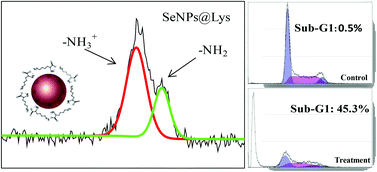Differential effects of amino acid surface decoration on the anticancer efficacy of selenium nanoparticles
Abstract
The use of selenium for anticancer therapy has been heavily explored during the last decade. Amino acids (AAs) play central roles both as building blocks of proteins and intermediates in metabolism. In the present study, AAs-modified selenium nanoparticles (SeNPs@AAs) have been successfully synthesized in a simple redox system. Typical neutral (valine), acidic (aspartic acid) and basic (lysine) amino acids were used to decorate SeNPs, and the stable and homodisperse nanoparticles were characterized by zeta potential and transmission electron microscope. The result of X-ray photoelectron spectra (XPS) showed that the interaction of –NH3+ groups of the amino acids with negative-charged SeNPs could be a driving force for dispersion of the nanoparticles. The screening of in vitro anticancer activities demonstrated that SeNPs@AAs exhibited differential growth inhibitory effects on various human cancer cell lines. Among them, SeNPs decorated by Lys displayed higher anticancer efficacy than those of valine and aspartic acid. The studies on the in vitro cellular uptake mechanisms revealed that SeNPs@AAs were internalized by cancer cells through endocytosis. Flow cytometric analysis and the determination of caspase activity indicated that treatment of the MCF-7 breast adenocarcinoma cells with SeNPs@AAs led to a dose-dependent increase in apoptosis. Moreover, it was found that SeNPs@AAs-induced ROS overproduction could be the upstream signal of caspase activation and mitochondrial dysfunction in cancer cells. Taken together, our results suggest that these amino acid biocompatible nanoparticles might have potential application as chemopreventive and chemotherapeutic agents for human cancers.


 Please wait while we load your content...
Please wait while we load your content...